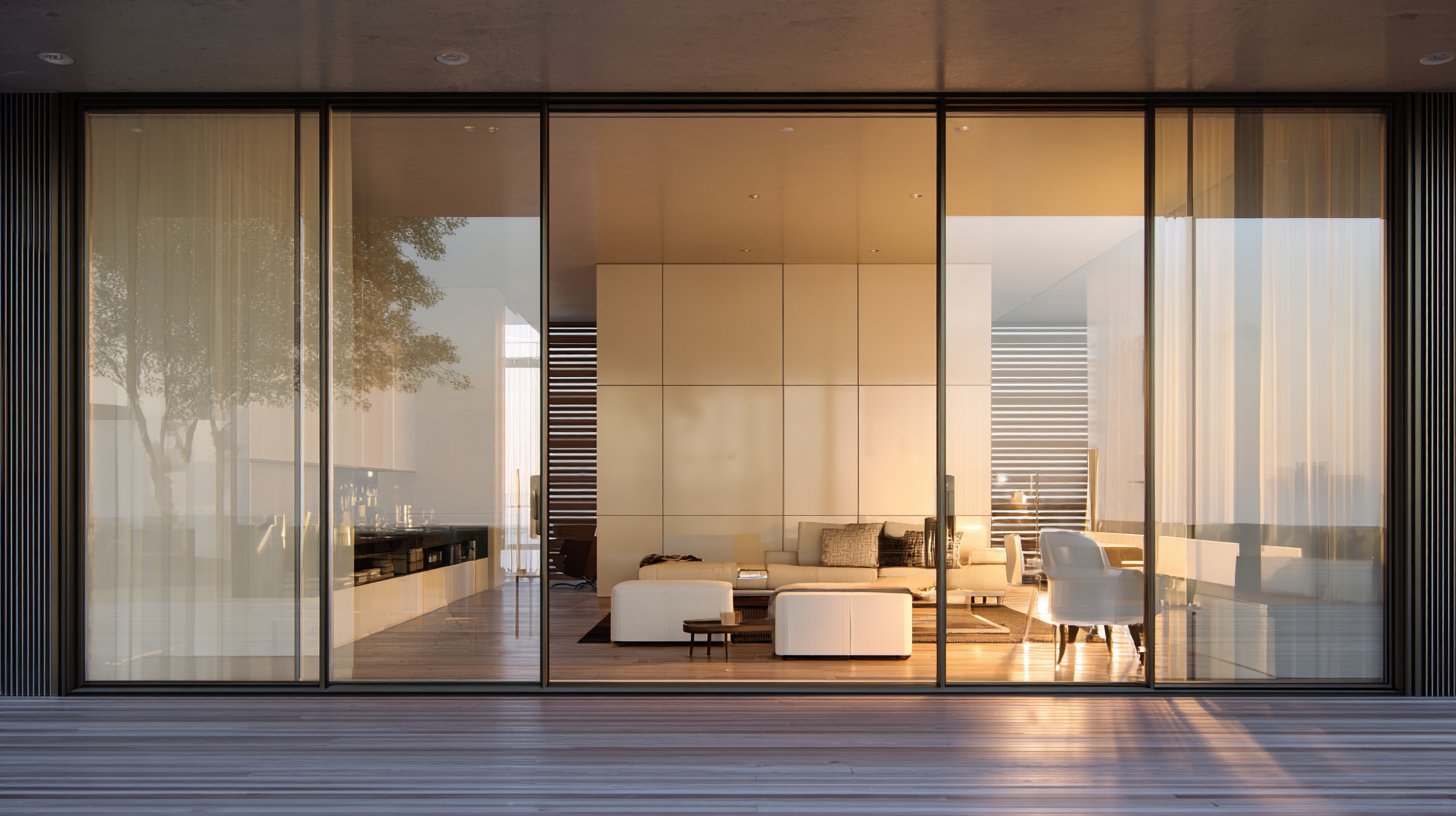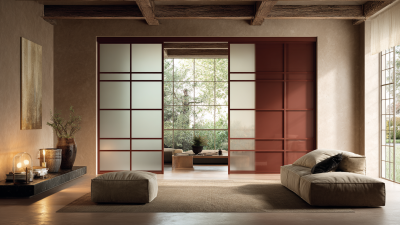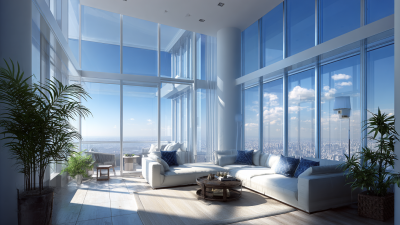Transform Your Space: Innovative Uses of Sliding Doors for Modern Home Design
Sliding doors have rapidly gained popularity in modern home design, serving as both functional elements and innovative aesthetic features. According to a 2022 report by the American Institute of Architects, sliding doors are increasingly being incorporated into residential builds, with a notable 35% of architects citing them as a key trend for enhancing indoor-outdoor connectivity. This design choice not only maximizes natural light but also improves space efficiency, aligning with the growing homeowner desire for multifunctional environments. The versatility of sliding doors allows them to be utilized in various areas—be it for separating living spaces, creating seamless transitions to outdoor patios, or even enhancing storage solutions within compact homes. As the contemporary focus shifts towards open floor plans and creating harmonious living spaces, the innovative uses of sliding doors can redefine the functionality and aesthetic appeal of any home environment.

Table of Contents
[Hide]
Creative Ways to Incorporate Sliding Doors in Small Spaces
Sliding doors can dramatically transform small spaces in modern homes, offering both aesthetic appeal and functional versatility. Their innovative use helps to create seamless transitions between rooms, particularly in open floor plans, which are increasingly favored in contemporary design. According to a recent report from the American Institute of Architects, 75% of homeowners prefer open spaces to enhance flow and connectivity in their homes. Sliding doors can be an ingenious solution to maintain this feeling of openness while still allowing for privacy when needed.
In smaller rooms, incorporating sliding doors can save valuable floor space that traditional doors might otherwise occupy. For instance, in multi-functional rooms such as a small bedroom that also serves as a home office, a sliding door can effectively section off the workspace without the bulkiness of a standard door. Designers are capitalizing on this trend by integrating stylish sliding doors in various materials—from sleek glass to rustic barn-style designs. This versatility not only enhances the room's aesthetic but also increases its functionality, allowing for creative organization solutions, as suggested by recent findings highlighting how luxurious wall treatments can elevate compact spaces.
Transform Your Space: Innovative Uses of Sliding Doors for Modern Home Design
| Application | Description | Advantages | Best Use |
|---|---|---|---|
| Room Divider | Creates distinct spaces in open floor plans. | Maximizes space utilization, adds flexibility. | Living rooms, studios. |
| Closet Doors | Saves space while adding style to closets. | Enhances organization and accessibility. | Bedrooms, hallways. |
| Patio Access | Connects indoor spaces with outdoor areas. | Increases natural light and flow. | Living rooms, dining rooms. |
| Bathroom Privacy | Provides a stylish way to separate bathroom areas. | Flexibility and modern aesthetics. | Bathrooms, en-suites. |
| Office Separation | Allows for an open office feel, can be closed off as needed. | Enhances productivity while saving space. | Home offices, workspaces. |
Transforming Living Areas with Multi-Functional Sliding Door Designs
Sliding doors are rapidly becoming an essential element in modern home design, particularly in creating versatile living spaces. As homes shrink in size and functionality becomes paramount, innovative sliding door designs offer homeowners a way to maximize space efficiently. For instance, sliding doors not only serve as room dividers but also help in transitioning spaces seamlessly, which is particularly valuable in multi-functional areas. Reports indicate that homes with adjustable layouts, including sliding doors, can increase overall space utilization by up to 30%, making them a favorite in metropolitan living.
Furthermore, integrating sliding doors with multifunctional furniture can transform traditional settings, such as a formal dining room, into a cozy workspace or entertainment area. This trend aligns with the growing preference for flexible living spaces, where the same room serves multiple purposes throughout the day. Industry insights reveal that personalizing these designs according to individual lifestyle needs can enhance the aesthetic appeal while boosting property value. As we approach 2025, the emphasis on sustainability and harmony with nature will further inspire innovative designs that incorporate sliding doors, making them not just a stylistic choice but a crucial component in functional home design.

Enhancing Natural Light and Open Flow with Glass Sliding Doors
In modern home design, glass sliding doors have emerged as a transformative element that enhances natural light and creates an open flow throughout living spaces. According to a report by the American Institute of Architects, homes that incorporate expansive glass elements can increase energy efficiency while enhancing the aesthetic appeal. The use of sliding doors allows homeowners to seamlessly connect indoor and outdoor environments, which has been shown to improve the feeling of spaciousness—an essential aspect for contemporary living.
Moreover, a survey by the National Association of Home Builders found that 87% of home buyers consider the availability of natural light crucial in their home-buying decision. Glass sliding doors effectively bring in abundant daylight, reducing the need for artificial lighting during the day and leading to significant energy savings. Additionally, the open flow created by sliding doors promotes airflow and enhances the overall comfort of the space, making it an ideal choice for creating inviting and functional home environments.

Stylish Privacy Solutions: How Sliding Doors Can Redefine Rooms
Sliding doors are increasingly becoming a stylish and practical solution for modern home design, providing an elegant way to ensure privacy without sacrificing space. According to a recent report by the National Kitchen & Bath Association, nearly 45% of homeowners are now opting for multifunctional spaces that seamlessly blend functionality and aesthetics. Sliding doors allow for the flexible reconfiguration of areas, making them ideal for homes that prioritize open layouts while still needing designated zones for privacy.
Moreover, the use of sliding doors can enhance the flow of natural light while still creating a sense of separation. A study from the American Institute of Architects indicates that homes with sliding glass doors can receive up to 30% more natural light than those with traditional swinging doors. This not only reduces the reliance on artificial lighting but also contributes to the overall wellness of residents, creating a more inviting and uplifting atmosphere. As designers and homeowners explore innovative ways to redefine spaces, sliding doors emerge as a stylish solution that meets the needs of the modern lifestyle.
Integrating Sliding Doors into Outdoor Living for Seamless Transitions
Sliding doors have become a quintessential element in modern home design, especially when it comes to integrating indoor and outdoor living spaces. Their ability to create seamless transitions enhances the flow of natural light and offers breathtaking views of your outdoor environment. By incorporating sliding doors into your home’s design, you not only expand your living space but also encourage a lifestyle that blurs the lines between indoor comfort and outdoor enjoyment.
**Tips:** When planning to install sliding doors, consider floor-to-ceiling options to maximize natural light and breathtaking views. Additionally, you might want to explore sliding doors with energy-efficient glazing to maintain indoor temperature while reducing energy costs. Lastly, pairing your sliding doors with outdoor elements like a well-placed patio or garden can create an inviting atmosphere that encourages relaxation and gatherings.
Integrating sliding doors leads to countless design possibilities, such as creating open-concept living areas that extend outside during warm months. Choose materials that complement your home's aesthetic—wood adds warmth, while aluminum offers a sleek, modern vibe. Embrace the versatility of sliding doors to transform your space into a harmonious blend of style and functionality, allowing you to fully enjoy both your living areas and the beauty of nature just beyond your threshold.
Impact of Sliding Doors on Modern Home Design
This chart illustrates the increasing trends in the usage of sliding doors in modern home designs over the last decade, highlighting their innovative applications in integrating indoor and outdoor living spaces.
Related Posts
-

7 Best Sliding Doors for Modern Homes That Elevate Your Space
-

How to Choose the Perfect Sliding Doors for Your Home
-

How to Choose the Perfect Sliding Doors for Your Home
-

How to Choose the Perfect Sliding Doors for Your Home
-

Exploring Unique Alternatives to Traditional Big Windows for Modern Spaces
-

The Ultimate Guide to Choosing the Perfect Home Doors for Every Style and Budget